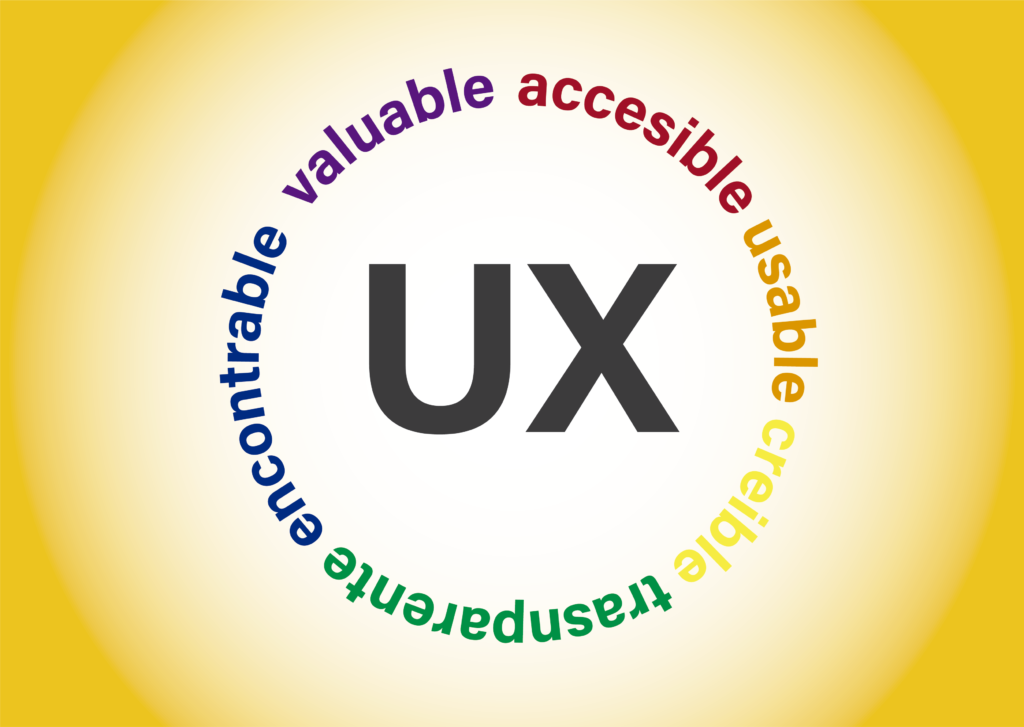How to correctly use the Ux philosophy in your projects
What is it and how to correctly use the Ux philosophy?
You’ve probably heard the term Ux several times, but do you know exactly what it means? Do you know how to correctly use the Ux philosophy optimally? Today we will show you how.
What is Ux?
The Ux (User Experience) or user experience, is what a person usually perceives when interacting with a product or service. To achieve a good user experience you have to focus on designing usable, desirable, useful, and structured products. All this should make the user feel happy and satisfied.

After several eras where the focus was on production and the product, a user-centered approach is born where the person/user is the important thing. Around this time (which is also the time of the digital age) the Ux was born to respond to the needs and motivations of the client and to make products and services as optimal and intuitive as possible.
The UX designer works through hypotheses, which he will have to validate through a combination of mostly qualitative techniques. These techniques are what help to research, organize, structure, design, and evaluate a good product for the key audience.
Below are several points for developing a good Ux.
The user is the center of everything
The user must be involved at all times and in all phases of the design process through methodologies or research in which they can participate. That helps to really know what the user wants and act accordingly when designing.
Follow a design process
There are many different ways to represent the design process that a good Ux can follow, but the idea lies in constantly researching and designing at each of the stages. the most basic process is Analysis, design, and evaluation.
The Ux designer does not usually investigate, design, and evaluate the solo, it is usually an entire team that is responsible for developing this process successfully.
There are several more complete processes such as the ISO 9241-210 DCU process, agile development, or lean Ux.
The UX process has to be iterative
Iterative means that it is repeated, that it never ends. That means that the Ux team has to make successive versions of a design to be able to get an optimal product Sometimes we have to teach the user something that they may not like at first, and then discover how to improve it.
Although we are at an advanced stage of evaluation, we can always return to a stage of research or design when faults or new user needs are found.
The design team has to include multidisciplinary profiles
To cover all needs and problems, it is recommended that there be experts in various fields, including experts in accessibility, business, marketing, developers, anthropologists, and researchers.
Use Ux methodologies
The methodologies used by Ux designers are very varied. They are usually innovative or redesigned methodologies. Below we show you the ones we recommend at each stage of the design process:
1.Analysis
- Ethnographic methodologies: It covers a set of methodologies that come from anthropology, in which its objective is to observe how the user behaves using the product or service in its context. Among them we can highlight Netnography (observation of the user on the web with the product), contextual observation (observation of the user in his environment using the product) and diaries (creation of diaries by the user, commenting on his experience with the product). These methods throw a lot of information about our user, their needs and motivations in the given text.
- Interviews: This is a face-to-face conversation with the end user, to learn more about them and their needs. It can be structured, semi-structured or open. Interviews also help us detect inconsistencies between what is said and what is done. They also allow us to collect information to create personal users.
- Benchmarking: It is used at the beginning of the process to make a comparison of the competition and thus know the weaknesses of each product and the strengths with the aim of presenting the best product to the client.
- Card sorting: is a method where the user orders a series of cards with their mental schemes. it is usually used to structure and rank well the categories of a web site.
2.Design
- The customer journey map: Helps to identify how users live throughout the use of the product. It is usually like a kind of infographic with the different stages that the user goes through. It can be used as a diagnostic tool and also as a design tool.
- People: They are used to identify the different users or archetypes that our product or service has. It helps us to keep in mind the needs of our user, the motivations and their characteristics.
- Wireframes: When all the ideas are sorted out at the analysis stage, it’s time to take action. Everything discovered above will be translated into Wireframes mode. They can be made both in pencil and digitally.
3.Evaluation
- Heuristic evaluation: it is an evaluation method in which several usability experts evaluate the product through a series of principles or guides. It is not as effective as a test with users, but combining it with this, you will get excellent results.
- Usability test: It is a method that is based on testing the product with users. With this we can find out if there are any usability errors in our product before launching it on the market.
Mix different methodologies to validate the information
To validate the information collected, several methodologies must be combined. For example, use some ethnographic methodology and then validate the information through interviews with potential key users. This form of validation is called “triangulation”.
So, what are the benefits of using the Ux philosophy correctly?
- Less costs in solving problems: by involving the user during all phases, the idea is correct, and it is cheaper to modify only the prototype than the idea itself. Therefore it produces less costs.
- Less risk: With the UX user-centric design approach we make sure that problems are discovered and fixed during design and not when the product is already on sale. Creating less risk of failure for the product / service that is made
- Detect more opportunities: having continuous analysis and research allows us to uncover opportunities and advantages that would otherwise be hidden.
- Less time to launch a product: With user-centered design, decisions are faster. Since the information comes directly from the user and is better validated.
In conclusion
For this and much more, we recommend that you use the Ux to improve your website, products, and services. Remember that behind an incredible product there has to be great previous work. Research and a correct strategy translated into an attractive interface are the keys to success. Not only UI is enough.


